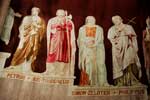Carpeting the world - from the White House to the Titanic
Published: 30 October 2006
Glasgow University is bidding to host the design archive of one of Scotland's oldest carpet companies, Stoddards Carpets
The Heritage Lottery Fund (HLF) has awarded a grant of £18,700 to the University of Glasgow to begin work to preserve the design archive of one of Scotland's oldest carpet companies, Stoddard Carpets. Stoddards provided the carpet the Queen walked on at her wedding, and also made the carpets for the White House in Washington, the Scottish Parliament and for both the original Titanic, and the movie of the same name. The Stoddard Archive includes designs by Charles Rennie Mackintosh, William Morris and Charles Voysey.
For over 18 months Ernst & Young, as the receivers of Stoddard International Plc, has been in discussions with a consortium of Glasgow heritage institutions headed by the University of Glasgow, to ensure the preservation of this important part of Scotland's textile history.
Recognising the significance of the archive, Tom Burton and Colin Dempster, the joint receivers at Ernst & Young, enlisted the help of Christie's to catalogue and value it. Interest was expressed by a number of parties from around the world.
The Stoddard Archive provides an historical record of the world-renowned carpet manufacturers James Templeton & Co, who, together with A F Stoddard and Henry Widnell & Stewart, merged to form Stoddard Carpets Ltd in 1983.
Tutti Frutti writer John Byrne is said to have based his play The Slab Boys on his experiences working as an apprentice designer in Stoddard's Elderslie factory.
Lesley Richmond, Director of Archive Services at the University of Glasgow, said: "This grant allows us to begin our project, Carpeting the World. Until now this collection has been inaccessible to heritage professionals, the general public, researchers, students and people working in the creative industries. The Stoddard companies not only put Glasgow designers on the world map but many of their creations were influenced by designs from all around the world. Stoddard and Templeton carpeted the houses of ordinary people as well as the well-off. We hope that this collection can be preserved in Glasgow for the future enjoyment of all its citizens."
Tom Burton from Ernst and Young added: "It is great news that the Heritage Lottery Fund has awarded a grant to the University consortium to develop their project to purchase the Archive. If the consortium were to acquire the Archive, it would remain intact, in Scotland and would be available to view and use, inspiring textile and other designers, as well as being accessible by the people of Scotland."
The consortium intends to make a Heritage Grant Project application to the Heritage Lottery Fund in the late Spring next year to purchase the archive, provide suitable storage and online resources for accessing and using the collection and the creation of an image gallery.
The Stoddard receivership started on 6 January 2005 and is almost complete. The Archive is one of the final assets still to be realised.
Kate Richardson (K.Richardson@admin.gla.ac.uk)
For more information please contact the University of Glasgow Media Relations Office on 0141 330 3683 or email K.Richardson@admin.gla.ac.uk
Images of carpet designs are available from the Media Relations Office.
The consortium consists of Glasgow University Archive Services, the Hunterian Art Gallery & Museum, Glasgow Museums and Glasgow School of Art.
The Stoddard Archive:
The Archive contains a wealth of visual material and also reflects changing fashions and the development of design since the mid?l9th century. It was a period when the decorative arts in Glasgow went from strength to strength, assuming international significance at the turn of the century through the work of Charles Rennie Mackintosh and his contemporaries.
There are a total of 2,500 design sketches dating from 1850?1940, the majority of which are from the 1890s and early 1900s. These are complemented by a photographic archive of carpet and rug designs produced between the late 19th century and mid?1950s, and 2,000 slides covering the firm?s output in the 1960s; also by an important collection of fabric samples and 83 carpets and rugs. Altogether they form a comprehensive record of commercial design in its various stages, which is augmented with an impressive library covering art, architecture, textiles and design. Among the range of books, folios, trade catalogues and periodicals are many rare volumes.
The collection is a tribute to the combination of business acumen, design flair and technical ingenuity which marked Templeton?s rise to international fame. In 1841 the founder of the firm, James Templeton, established a business in Glasgow manufacturing chenille carpets by a process he had patented with a Paisley weaver named Quigley. It was the era of great international exhibitions at which the firm carried off a succession of medals. The huge and magnificent ?Twelve Apostles? carpet for example (which is among those still held by Stoddard?s) was made especially for the Paris International Exhibition of 1867.
First published: 30 October 2006
<< October


